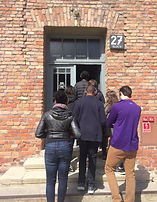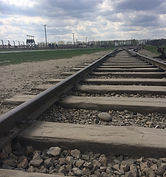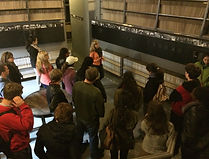
travel to Central and Eastern Europe
“The first feeling I felt at Majdanek was guilt. As we stood atop the hill on which the monument rested, I felt guilty thinking about how beautiful the landscape looked. I thought about the horrifying things that took place there, and I felt guilty being surrounded by beauty. Maybe the view was just as nice in the 1940s, but I felt guilty knowing I could enjoy it, and the prisoners of the concentration camp most definitely could not. I wanted the entire area to look like death and destruction like I had imagined in my head, but that was not the case. I felt guilty and saddened that the ugliness that took place in Majdanek was surrounded by such beauty.
Majdanek is also surrounded by a residential area. There is also a Catholic cemetery practically sitting in the camp. This was also the case during the 1940s. My guilt is nothing compared to those living in the houses surrounding Majdanek. Those visiting their loved ones’ graves. How could those living nearby not see the constant smoke from the crematorium? Not smell the scent of burning flesh? How could someone visiting the cemetery not catch a glimpse of Sonderkommandos carting countless bodies? In my opinion, it is next to impossible that no one saw anything. Absolutely impossible. Those living in the area who knew the crimes against humanity that were being committed in Majdanek, or were even suspicious of them, they are guilty as well. Perpetrators are not able to succeed without bystanders. Not in Majdanek, not in the Warsaw ghetto, not anywhere.
The beginning of ending injustice is standing up against it.”
--Reflections of a student traveler during the 2019 trip to Central and Eastern Europe
Annually since 2002 (with the exception of the COVID-affected years), dozens of students in the Facing History classes have traveled to Germany, Poland, and the Czech Republic. In some years, the group has also traveled to The Netherlands as a part of this trip. The focus of this academic, curricular trip is squarely on the history of the Holocaust and genocide, World War II, the Cold War and its aftermath, and present day Central and Eastern Europe. It is an extension of the curriculum that students in Facing History will have been exploring for much of the year and it offers a deep dive into the troubling history of the second half of the twentieth and the start of the twenty-first century.
The trip is a densely-packed, often exhausting trip through three countries with a laser focus on the past century. Consistently, students as well as faculty chaperones who participate in this trip demonstrate a seriousness of purpose and impressive stamina. They preserve their experiences through journaling, scrapbooking, and a communal blog. They return to Boston and share their experiences with their fellow students, families, and members of the extended school community.
In Germany, we visit Berlin, Dessau, Bernberg, Weimar, and Nuremberg. In Poland, we focus on Krakow, Oswiecim, Lublin, and Warsaw. In the Czech Republic, we spent time in Prague and Terezin.
Germany: In Berlin, we will visit sites key to the history of Nazi Germany, from the Wannsee Villa (where the Nazis’ so-called “Final Solution to the Jewish Problem” was approved), remnants of Hitler’s bunker to the old Reichstag (now the Bundestag), the various Nazi ministries, the new Topography of Terror Museum, Checkpoint Charlie, the Museum and Memorial to the Murdered Jews of Europe, the Jewish Museum of Berlin, the Pergamon Museum, the remains of the Berlin Wall, the bunkers under the city, memorials to the disabled, homosexuals, and Roma and Sinti. We will also visit with activists at the Afrikanische Viertel (African quarter), where their efforts are ongoing to remove vestiges and references to German colonial rule over parts of Africa, very much in evidence in this section of the city. Additionally, we typically make a day trip to visit the Bauhaus in Dessau and the euthanasia center at Bernburg and, in some years, the city of Weimar and the Buchenwald concentration camp.



Visiting the Haus der Wannsee Konferenz on the outskirts of Berlin
At the site of the Memorial to the Murdered Jews in Europe in Berlin
At Gleis 17, the area of the train station in Grünewald where deportations of Jews, Roma, and other prisoners to the east originated.

Entering Buchenwald concentration camp, overlooking the city of Weimar

Detail of Shalekhet (Fallen Leaves) by Israeli artist Menashe Kadishman, in the "Memory Void at the Jüdisches Museum in Berlin.

Remains of the Berlin Wall
Stolpersteine (Stumbling stones) marking the last residence of individuals who were victims of Nazi persecution
Poland: Poland is really the centerpiece of this trip. We begin in Krakow, one of the most well-preserved medieval “Old Towns” in Europe; Krakow somehow escaped significant bomb destruction during World War II. While in Krakow, we will visit Kazimierz, the Podgorze ghetto (and the Pharmacy Museum) in Krakow, the Schindler factory and the remnants of the Plaszow labor camp (both sites were prominently featured in the film Schindler’s List).
We then will spend a night in the Polish town of Oswiečim (German name: Auschwitz), a town that is an hour northwest of Krakow. The purpose of staying in Oswiečim overnight is to devote an entire day to visiting Auschwitz I, Auschwitz II (Birkenau), and the remains of Auschwitz III (Buna/Monowitz), the infamous Nazi death camps which are not only the largest site of human remains/cemetery in the world but also among the most powerful and disturbing sites in the world. During our time in the town, we also visit the nearby church complex where hundreds of remarkable works of art created by Auschwitz survivor Marian Kolodziej shortly before his death fills the entire crypt.
Following our time in Krakow/Oswiečim, we travel north, staying overnight in the city of Lublin in central Poland and visiting the concentration camp Majdanek, virtually intact as the Nazis hastened to flee the advancing Soviets instead of destroying the camp. Following our visit to Majdanek and a visit to the old town area of Lublin, we resume traveling north to Warsaw, where we will visit the remains of the ghetto in that city as well as the POLIN Museum for the History of the Jews in Poland. In Warsaw, Poland’s capital city, we also explore the ways in which the city has moved beyond its Communist era, how it has reckoned with its history during World War II, what the role of the Solidarity movement was in propelling Poland toward a democratic future, and how that future is possibly imperiled today.


The Axis of the Holocaust, on the lower level of the Jüdisches Museum Berlin.










The mass graves at the top of the hill at Majdanek, adjacent to the crematorium.
The barracks at Majdanek, where hundreds of prisoners slept in largely unheated wooden buildings designed for horses.
Entrance to Field III at Majdanek
View of a single bin (among hundreds) containing the shoes of victims of the death camp at Majdanek.
One of the two extant gas chamber buildings at Majdanek, labelled "Bath and Disinfection."
The chimney of the crematorium (left) and the Soviet-built memorial (right) containing the ashes of thousands of victims at Majdanek. Between them are the unmarked mass graves of approximately 43,000 victims of the killings at Majdanek on 3-4 November 1943.
The entrance to Auschwitz I, beneath the "Arbeit macht frei" (Works Makes One Free") slogan.
At Auschwitz II (Birkenau), walking along the site's periphery.
At Auschwitz II (Birkenau), on the platform adjacent to the train tracks, leading to the gas chamber complexes II and III.




The site where the camp orchestra of prisoners was forced to play.
Listening to Auschwitz Museum guide Wojciech Smolen at Auschwitz I.
At Auschwitz II (Birkenau), on the platform adjacent to the train tracks, leading to the gas chamber complexes II and III.

Auschwitz is the repository for personal belongings of victims murdered at the camp. From left to right: suitcases marked by the owners, bowls and dishes for food, cherished personal family photographs.



In Block 27 at Auschwitz I, there is a massive mounted book containing the names of nearly 4,000,000 known victims of the Holocaust. Many names are not known or recorded anywhere. Here our travelers searched the book and many find their surnames listed, often unaware that people with their same surname might have been victims of the Holocaust.



Views of Auschwitz II (Birkenau) from left to right: a train car on the now abandoned train tracks, the extant train tracks, and the barbed wire separating fields at the site.



In Lublin, at the Theatre NN site at the Grodka Gate Museum (left and center).
At the base of the memorial at the site of the Plaszow concentration camp (right).







At the Terezin (Theresienstadt) camp outside Prague.

The handpainted list of names of all Czech and Slovak victims of the Holocaust, from the Pinkas Synagogue in the Josefov area of Prague.
Czech Republic: During our time in Prague, we will tour the historic sites of the city, visit the remains of the Prague ghetto and the cemetery, and travel by bus to the ghetto/transit camp of Theresienstadt (Terezin), about one hour northwest of the city. Theresienstadt is a peculiar place and our visit helps to complicate our concept of what the Nazis did, what victims experienced, and what humanity is capable of doing. We will also visit the castle in Prague and tour the history of this historic city, focusing especially on Bohemian history, the Nazi occupation, Communist role, and the Velvet Revolution, as well as life in the present-day Czech Republic.
Germany: Finally, we return to Germany to visit Nürnberg (Nuremberg), site of the Nazi party’s annual September rallies as well as the postwar Nürnberg trial courtroom.
This trip is open only to students who have/are taking Facing History at Boston Latin School. The trip is an educational, curricular trip that is tailored to the Boston Latin School Facing History course. It is intended for students who are interested in a deep intellectual and academic experience. It is often said by students that it is a life-changing and unforgettable opportunity.
The trip offers an unparalleled opportunity for young people to walk in the footsteps of so many millions who lived, flourished and perished in these places. It affords students and faculty chaperones an opportunity to experience the power of place to enhance their understanding of history.
We are grateful to the Clough Center for Global Understanding for financial assistance to support all eligible students who wish to experience this truly unique opportunity. In some years, student travelers on the trip have also received financial support from the Checkpoint Charlie Stiftung and the Lewis Family Foundation.
To get a sense of the experiences students have had on this trip, please visit the various blogs that they have produced:

On the historic Charles Bridge in Prague.

Walking up the massive platform where the Nazis spoke at the Nuremberg rallies in the 1930s.

Our final day, at the Olympic Park in Munich.